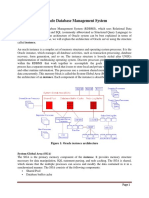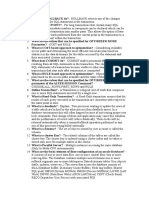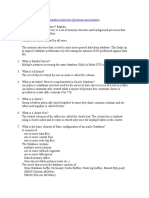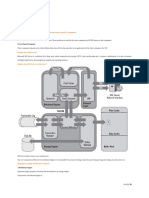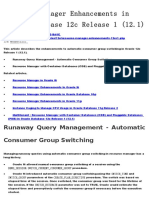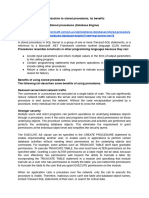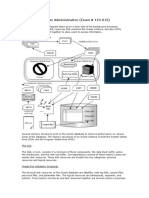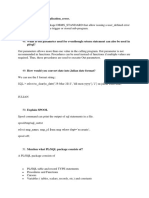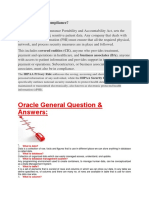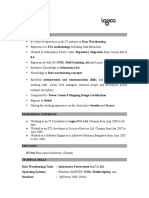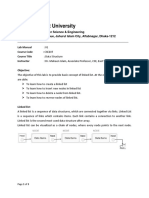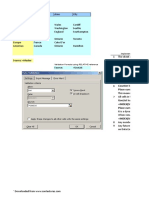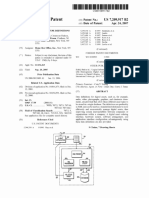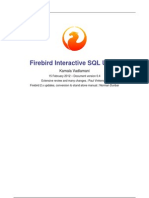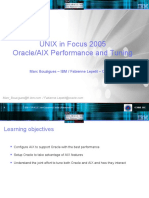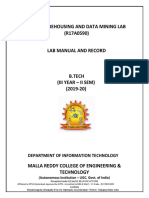Transitional Medical Assistance (TMA) Under Medicaid: Rowid Data Types
Transitional Medical Assistance (TMA) Under Medicaid: Rowid Data Types
Uploaded by
Sumit KCopyright:
Available Formats
Transitional Medical Assistance (TMA) Under Medicaid: Rowid Data Types
Transitional Medical Assistance (TMA) Under Medicaid: Rowid Data Types
Uploaded by
Sumit KOriginal Description:
Original Title
Copyright
Available Formats
Share this document
Did you find this document useful?
Is this content inappropriate?
Copyright:
Available Formats
Transitional Medical Assistance (TMA) Under Medicaid: Rowid Data Types
Transitional Medical Assistance (TMA) Under Medicaid: Rowid Data Types
Uploaded by
Sumit KCopyright:
Available Formats
Rowid Data Types
Every row stored in the database has an address. Oracle Database uses a ROWID data type to
store the address (rowid) of every row in the database. Rowids fall into the following categories:
Physical rowids store the addresses of rows in heap-organized tables, table clusters, and table and
index partitions.
Logical rowids store the addresses of rows in index-organized tables.
Foreign rowids are identifiers in foreign tables, such as DB2 tables accessed through a gateway.
They are not standard Oracle Database rowids.
Transitional Medical Assistance (TMA)
Under Medicaid
transitional Medical Assistance (TMA) Under Medicaid
Summary
Medicaid, a means-tested federal/state program that provides health care coverage
to certain groups of individuals, requires that states continue Medicaid benefits for
certain low-income families who would otherwise lose coverage because of
changes in their income. This continuation is known as transitional
medical assistance (TMA).
WIP Work in Process
Table Name Description
WIP_DISCRETE_JOBS Discrete jobs
WIP_ENTITIES Information common to jobs and schedules
WIP_LINES Production lines
WIP_MOVE_TRANSACTIONS Shop floor move transactions
WIP_MOVE_TXN_ALLOCATIONS Move transaction allocations for repetitive schedules
WIP_OPERATIONS Operations necessary for jobs and schedules
WIP_OPERATION_NETWORKS Operation dependency
WIP_OPERATION_OVERHEADS Overheads for operations in an average costing
organization
WIP_OPERATION_RESOURCES Resources necessary for operations
WIP_OPERATION_YIELDS This table keeps all costing information for operation yield
costing.
WIP_TRANSACTIONS WIP resource transactions
WIP_TRANSACTION_ACCOUNTS Debits and credits due to resource transactions
68. What is Cursor ?
A Cursor is a handle ( a name or pointer) for the memory
associated with a specific statement.
69. What is PGA ?
Program Global Area (PGA) is a memory buffer that contains
data and control information for a server
process.
70. What is User Process ?
A user process is created and maintained to execute the
software code of an application program. It
is a shadow process created automatically to facilitate
communication between the user and the
server process.
71. What is Server Process ?
Server Process handle requests from connected user
process. A server process is in charge of
communicating with the user process and interacting with
ORACLE carry out requests of the associated
user process.
72. What are the two types of Server Configurations ?
Dedicated Server Configuration and Multi-threaded Server
Configuration.
73. What is Dedicated Server Configuration ?
In a Dedicated Server Configuration a Server Process handles
requests for a Single User Process.
74. What is a Multi-threaded Server Configuration ?
In a Multi-threaded Server Configuration many user
processes share a group of server process.
75. What is a Parallel Server option in ORACLE ?
A configuration for loosely coupled systems where multiple
instance share a single physical database
is called Parallel Server.
76. Name the ORACLE Background Process ?
DBWR Database Writer.
LGWR Log Writer
CKPT Check Point
SMON System Monitor
PMON Process Monitor
ARCH Archiver
RECO Recover
Dnnn Dispatcher, and
LCKn Lock
Snnn Server.
77. What Does DBWR do ?
Database writer writes modified blocks from the database
buffer cache to the data files.
78.When Does DBWR write to the database ?
DBWR writes when more data needs to be read into the SGA
and too few database buffers are free. The
least recently used data is written to the data files first.
DBWR also writes when CheckPoint
occurs.
79. What does LGWR do ?
Log Writer (LGWR) writes redo log entries generated in the
redo log buffer of the SGA to on-line
Redo Log File.
80. When does LGWR write to the database?
LGWR writes redo log entries into an on-line redo log file
when transactions commit and the log
buffer files are full.
81. What is the function of checkpoint CKPT)?
The Checkpoint (CKPT) process is responsible for signaling
DBWR at checkpoints and updating all the
data files and control files of the database.
82. What are the functions of SMON ?
System Monitor (SMON) performs instance recovery at
instance start-up. In a multiple instance system
(one that uses the Parallel Server), SMON of one instance
can also perform instance recovery for
other instance that have failed SMON also cleans up
temporary segments that are no longer in use and
recovers dead transactions skipped during crash and
instance recovery because of file-read or
off-line errors. These transactions are eventually recovered
by SMON when the tablespace or file is
brought back on-line SMON also coalesces free extents
within the database to make free space
contiguous and easier to allocate.
83. What are functions of PMON ?
Process Monitor (PMON) performs process recovery when a
user process fails PMON is responsible for
cleaning up the cache and Freeing resources that the
process was using PMON also checks on
dispatcher and server processes and restarts them if they
have failed.
84. What is the function of ARCH ?
Archiver (ARCH) copies the on-line redo log files to archival
storage when they are full. ARCH is
active only when a databases redo log is used in
ARCHIVELOG mode.
85. What is function of RECO ?
RECOver (RECO) is used to resolve distributed transactions
that are pending due to a network or
system failure in a distributed database. At timed
intervals,the local RECO attempts to connect to
remote databases and automatically complete the commit
or rollback of the local portion of any
pending distributed transactions.
86. What is the function of Dispatcher (Dnnn) ?
Dispatcher (Dnnn) process is responsible for routing requests
from connected user processes to
available shared server processes and returning the
responses back to the appropriate user
processes.
87. How many Dispatcher Processes are created ?
Atleast one Dispatcher process is created for every
communication protocol in use.
88. What is the function of Lock (LCKn) Process ?
Lock (LCKn) are used for inter-instance locking when the
ORACLE Parallel Server option is used.
89. What is the maximum number of Lock Processes used ?
Though a single LCK process is sufficient for most Parallel
Server systems
upto Ten Locks (LCK0,.LCK9) are used for inter-instance
locking.
DATA ACCESS
90. Define Transaction ?
A Transaction is a logical unit of work that comprises one or
more SQL statements executed by a
single user.
91. When does a Transaction end ?
When it is committed or Rollbacked.
92. What does COMMIT do ?
COMMIT makes permanent the changes resulting from all
SQL statements in the transaction. The changes
made by the SQL statements of a transaction become visible
to other user sessions transactions that
start only after transaction is committed.
93. What does ROLLBACK do ?
ROLLBACK retracts any of the changes resulting from the
SQL statements in the transaction.
94. What is SAVE POINT ?
For long transactions that contain many SQL statements,
intermediate markers or savepoints can be
declared which can be used to divide a transaction into
smaller parts. This allows the option of
later rolling back all work performed from the current point
in the transaction to a declared
savepoint within the transaction.
95. What is Read-Only Transaction ?
A Read-Only transaction ensures that the results of each
query executed in the transaction are
consistant with respect to the same point in time.
96. What is the function of Optimizer ?
The goal of the optimizer is to choose the most efficient
way to execute a SQL statement.
97. What is Execution Plan ?
The combinations of the steps the optimizer chooses to
execute a statement is called an execution
plan.
You might also like
- Oracle SQLDocument127 pagesOracle SQLsoireeNo ratings yet
- Quick Oracle 9i Performance Tuning Tips & ScriptsDocument7 pagesQuick Oracle 9i Performance Tuning Tips & ScriptsEder CoutoNo ratings yet
- Oracle Architecture Interview QuestionsDocument11 pagesOracle Architecture Interview QuestionsAnush Reddy100% (1)
- 3010 - Amadeus Format ComparisonDocument3 pages3010 - Amadeus Format ComparisonMabs Gadd100% (1)
- Oracle Database Questions & Answers 3Document35 pagesOracle Database Questions & Answers 3culbeciNo ratings yet
- Business Intelligence: Explain The Architecture of SQL Reporting ServiceDocument18 pagesBusiness Intelligence: Explain The Architecture of SQL Reporting Servicejanakiram77No ratings yet
- Database AdministrationDocument138 pagesDatabase AdministrationMir HusenNo ratings yet
- Parameter? - COST and RULEDocument3 pagesParameter? - COST and RULEraajiNo ratings yet
- Oracle Questions Test3Document3 pagesOracle Questions Test3Sumit KNo ratings yet
- SQL Server Detailed ArchitectureDocument15 pagesSQL Server Detailed ArchitectureMadhu ThellaNo ratings yet
- 50 Networking Interview Questions and Answers - Sreesankar 20511Document8 pages50 Networking Interview Questions and Answers - Sreesankar 20511Sree SankarNo ratings yet
- Transaction Management and RecoveryDocument32 pagesTransaction Management and RecoverybmintegNo ratings yet
- Networking & MCSE Interview Questions and AnswersDocument23 pagesNetworking & MCSE Interview Questions and AnswersSudhir MaherwalNo ratings yet
- Database Management SystemDocument23 pagesDatabase Management SystemHiral BhardwajNo ratings yet
- Datastage Interview Question and AnswersDocument14 pagesDatastage Interview Question and AnswersPramod Ranjan100% (2)
- Re: What Is Difference Between Fat & Ntfs AnswerDocument4 pagesRe: What Is Difference Between Fat & Ntfs AnswerBalachand Kumar RaoNo ratings yet
- SQL Server ArchitectureDocument13 pagesSQL Server ArchitectureMadhan MohanNo ratings yet
- Q Rep DB2 OracleDocument34 pagesQ Rep DB2 OracleRamchandra RaikarNo ratings yet
- What Is Database?: Types of Work Process in SAP InterfaceDocument5 pagesWhat Is Database?: Types of Work Process in SAP InterfacebasisashNo ratings yet
- SQL Server ArchitectureDocument20 pagesSQL Server ArchitectureRajkumar DevarajuNo ratings yet
- 9i Architecture: User ProcessDocument7 pages9i Architecture: User ProcessMahidhar KoppulaNo ratings yet
- SQL Server DBADocument4 pagesSQL Server DBAAbhinav MishraNo ratings yet
- Operating System: COPE/Technical Test/Interview/Database Questions & AnswersDocument25 pagesOperating System: COPE/Technical Test/Interview/Database Questions & AnswersVasu DevanNo ratings yet
- Oracle Book-Final FormattedDocument168 pagesOracle Book-Final Formattedkranthi633100% (1)
- SQL Server Architecture - PPTDocument20 pagesSQL Server Architecture - PPTRajkumar DevarajuNo ratings yet
- Viva Voce QuestionsDocument6 pagesViva Voce QuestionsKumar VarunNo ratings yet
- Stored ProceduresDocument2 pagesStored ProceduresG.C.ReddyNo ratings yet
- What Is The Difference Between Product Based and Service Based IT Companies?Document36 pagesWhat Is The Difference Between Product Based and Service Based IT Companies?gopinath_150840358No ratings yet
- SQL Server DBA Interview QuestionsDocument3 pagesSQL Server DBA Interview Questionsjeffa123100% (2)
- SQL Technical INterview PDFDocument13 pagesSQL Technical INterview PDFGuru100% (1)
- Oracle DBA 11gR2 ArchitectureDocument9 pagesOracle DBA 11gR2 ArchitectureAzmath Tech TutsNo ratings yet
- Infa 120 Corrected TotallyDocument22 pagesInfa 120 Corrected Totallyrogul95No ratings yet
- PIA Training Centre Prime CommunicationsDocument14 pagesPIA Training Centre Prime CommunicationsArbabNo ratings yet
- 000 Basics and IntroductionDocument7 pages000 Basics and IntroductionsureshtNo ratings yet
- Oracle DBA NotesDocument17 pagesOracle DBA NotesGurusamy V78% (9)
- Resource Manager Enhancements In-12cDocument4 pagesResource Manager Enhancements In-12cAnbao ChengNo ratings yet
- Oracle DBADocument187 pagesOracle DBAudai pratap100% (2)
- Oracle DBA InterviewDocument73 pagesOracle DBA InterviewjaydevdangarNo ratings yet
- Introduction To Stored Procedures Its BenefitsDocument3 pagesIntroduction To Stored Procedures Its Benefitsisfaq.ansNo ratings yet
- QuestionaireDocument106 pagesQuestionairevenkatsainath06No ratings yet
- Chapter 10 DbmsDocument9 pagesChapter 10 DbmsSaloni VaniNo ratings yet
- DBCC, DMVs and PT Q&ADocument12 pagesDBCC, DMVs and PT Q&AAsim KhanNo ratings yet
- Oracle DBA Interview QuestionsDocument16 pagesOracle DBA Interview QuestionsfkhalidNo ratings yet
- MS SQLDocument46 pagesMS SQLKeerthi MenonNo ratings yet
- SQL Server Interview Questions: Explain The Use of Keyword WITH ENCRYPTION. Create A Store Procedure With EncryptionDocument10 pagesSQL Server Interview Questions: Explain The Use of Keyword WITH ENCRYPTION. Create A Store Procedure With EncryptionSreenivaas SurathuNo ratings yet
- Study Material For OracleDocument198 pagesStudy Material For OracleSarath ChandraNo ratings yet
- Study Material For OracleDocument197 pagesStudy Material For OracleSidharth SontiNo ratings yet
- Oracle 8: Database Administration (Exam # 1Z0-013) : The SgaDocument16 pagesOracle 8: Database Administration (Exam # 1Z0-013) : The SgaAnonymous qPo1wFyH0ENo ratings yet
- 2 - Oracle OCP ExamDocument16 pages2 - Oracle OCP ExamAnonymous qPo1wFyH0ENo ratings yet
- Developer and DBA Tips For Pro-Actively Optimizing SQL Apply Performance PDFDocument16 pagesDeveloper and DBA Tips For Pro-Actively Optimizing SQL Apply Performance PDFThana Balan SathneeganandanNo ratings yet
- Implementing Data GuardDocument33 pagesImplementing Data GuardRavi PrakashNo ratings yet
- PL SQL Interview QnsDocument182 pagesPL SQL Interview Qnsmustafa2376100% (1)
- ORACLE PL/SQL Interview Questions You'll Most Likely Be AskedFrom EverandORACLE PL/SQL Interview Questions You'll Most Likely Be AskedRating: 5 out of 5 stars5/5 (1)
- Oracle Database 11g - Underground Advice for Database Administrators: Beyond the basicsFrom EverandOracle Database 11g - Underground Advice for Database Administrators: Beyond the basicsNo ratings yet
- Part 20Document2 pagesPart 20Sumit KNo ratings yet
- Question #1) Differentiate PL/SQL and SQL?: o o o o o oDocument5 pagesQuestion #1) Differentiate PL/SQL and SQL?: o o o o o oSumit KNo ratings yet
- Part 21Document2 pagesPart 21Sumit KNo ratings yet
- Oracle Fusion HCM Data LoaderDocument3 pagesOracle Fusion HCM Data LoaderSumit KNo ratings yet
- Part 13Document1 pagePart 13Sumit KNo ratings yet
- PLVCMT: PLVCMT Package Wraps Logic and Complexity For Dealing With Commit PLVRB: It Provides A Programmatic Interface To Roll-Back Activity in PL/SQLDocument1 pagePLVCMT: PLVCMT Package Wraps Logic and Complexity For Dealing With Commit PLVRB: It Provides A Programmatic Interface To Roll-Back Activity in PL/SQLSumit KNo ratings yet
- Part 5Document3 pagesPart 5Sumit KNo ratings yet
- Oracle SQL/PLSQL Questions & Answers:: Federal Poverty Level (FPL)Document1 pageOracle SQL/PLSQL Questions & Answers:: Federal Poverty Level (FPL)Sumit KNo ratings yet
- PA (Premium Assistance) : Rowid Data TypesDocument2 pagesPA (Premium Assistance) : Rowid Data TypesSumit KNo ratings yet
- Master The Mapreduce Computational Engine in This In-Depth Course!Document2 pagesMaster The Mapreduce Computational Engine in This In-Depth Course!Sumit KNo ratings yet
- Obamacare Cost Assistance Subsidy Facts: Rowid Data TypesDocument3 pagesObamacare Cost Assistance Subsidy Facts: Rowid Data TypesSumit KNo ratings yet
- How To Qualify For Health Insurance Subsidies: Executive SummaryDocument12 pagesHow To Qualify For Health Insurance Subsidies: Executive SummarySumit KNo ratings yet
- Top Answers To PL-SQL Interview QuestionsDocument1 pageTop Answers To PL-SQL Interview QuestionsSumit KNo ratings yet
- Top Answers To Map Reduce Interview Questions: Criteria Mapreduce SparkDocument2 pagesTop Answers To Map Reduce Interview Questions: Criteria Mapreduce SparkSumit KNo ratings yet
- Oracle General Question & Answers:: What Is HIPAA Compliance?Document5 pagesOracle General Question & Answers:: What Is HIPAA Compliance?Sumit KNo ratings yet
- Advance Premium Tax Credit (APTC) : Rowid Data TypesDocument4 pagesAdvance Premium Tax Credit (APTC) : Rowid Data TypesSumit KNo ratings yet
- Oracle SQL/PLSQL Questions & Answers:: Federal Poverty Level (FPL)Document1 pageOracle SQL/PLSQL Questions & Answers:: Federal Poverty Level (FPL)Sumit KNo ratings yet
- How To Save On Your Monthly Insurance Bill With A Premium Tax CreditDocument10 pagesHow To Save On Your Monthly Insurance Bill With A Premium Tax CreditSumit KNo ratings yet
- What Is Masshealth?: Rowid Data TypesDocument4 pagesWhat Is Masshealth?: Rowid Data TypesSumit KNo ratings yet
- Oracle General Question & Answers:: What Is HIPAA Compliance?Document4 pagesOracle General Question & Answers:: What Is HIPAA Compliance?Sumit KNo ratings yet
- Oracle SQL24Document4 pagesOracle SQL24Sumit KNo ratings yet
- QA AJP 22517 Exp 20Document2 pagesQA AJP 22517 Exp 20Neeraj SurnisNo ratings yet
- Chennai 5.02 YrsDocument7 pagesChennai 5.02 Yrsvenkat prasadNo ratings yet
- Online Auction SynopsisDocument24 pagesOnline Auction SynopsisAshim Ranjan BoraNo ratings yet
- 67031-Data Science As ServiceDocument8 pages67031-Data Science As ServiceTao Jung WangNo ratings yet
- CSE 207 - Lab-2Document3 pagesCSE 207 - Lab-2tamimNo ratings yet
- Mongodb (Cont.) : Excerpts From "The Little Mongodb Book" Karl SeguinDocument37 pagesMongodb (Cont.) : Excerpts From "The Little Mongodb Book" Karl Seguinjorge alvarezNo ratings yet
- Active DatabasesDocument22 pagesActive Databasesradhikakumaran3No ratings yet
- STUTI - GUPTA Hadoop Resume PDFDocument2 pagesSTUTI - GUPTA Hadoop Resume PDFNoble kumarNo ratings yet
- Writing Good SQLDocument13 pagesWriting Good SQLKumara55No ratings yet
- AEOS Liquibase Tool Installation & Configuration Manual EnglishDocument10 pagesAEOS Liquibase Tool Installation & Configuration Manual Englishtvghardaia1No ratings yet
- Kafka PDFDocument106 pagesKafka PDFsarim siddiquiNo ratings yet
- RJG Universal DD DependentDocument7 pagesRJG Universal DD DependentAMIT AMBRENo ratings yet
- Top Talkers SOPv1Document3 pagesTop Talkers SOPv1Gaurav NayakNo ratings yet
- Week-05 AssignmentDocument5 pagesWeek-05 AssignmentPrabha KNo ratings yet
- 2nd SQL Interview Questions (2022) - JavatpointDocument50 pages2nd SQL Interview Questions (2022) - Javatpointomkar gaikwadNo ratings yet
- United States Patent: Probst Et Al. (45) Date of Patent: Apr. 24, 2007Document19 pagesUnited States Patent: Probst Et Al. (45) Date of Patent: Apr. 24, 2007Budi SeptiawanNo ratings yet
- Kalyan Sap BW Bi Bo 1Document7 pagesKalyan Sap BW Bi Bo 1jay_kay706348100% (1)
- System Design: Context Flow DiagramDocument7 pagesSystem Design: Context Flow DiagramAshish KrishnaNo ratings yet
- Chapter 10Document45 pagesChapter 10Sarita SamalNo ratings yet
- Normalisation in MS AccessDocument11 pagesNormalisation in MS AccessFrances VorsterNo ratings yet
- Data Mining Exam QuestionsDocument25 pagesData Mining Exam Questionsdata.ana18No ratings yet
- MCSM Directory Reading List June 2013Document17 pagesMCSM Directory Reading List June 2013Sudha GaddamNo ratings yet
- Modeling For AS ScalabilityDocument11 pagesModeling For AS ScalabilityYasstonNo ratings yet
- Firebird IsqlDocument43 pagesFirebird IsqlMargarito Navarrete-MendozaNo ratings yet
- CS - ALL - Practical FileDocument34 pagesCS - ALL - Practical FilebrijeshNo ratings yet
- Aix Tun Oracle 2Document53 pagesAix Tun Oracle 2madunixNo ratings yet
- BLPR.R16349 - Cementitious Cement and Plaster Mixtures UL Product IqDocument1 pageBLPR.R16349 - Cementitious Cement and Plaster Mixtures UL Product IqRalph Ian MalabananNo ratings yet
- Clean LogDocument3 pagesClean LogHKM PUDUNo ratings yet
- It Iii B.tech Sem-Ii Dwdm-R17a0590 Lab Manual 2019-20Document107 pagesIt Iii B.tech Sem-Ii Dwdm-R17a0590 Lab Manual 2019-20Lea May ReoraNo ratings yet







